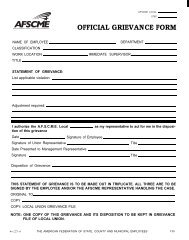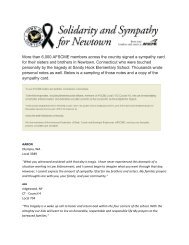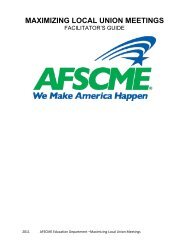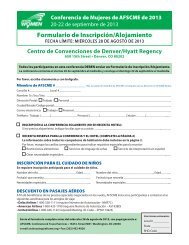Florida's Experiment with Privatizing Child Welfare Services - AFSCME
Florida's Experiment with Privatizing Child Welfare Services - AFSCME
Florida's Experiment with Privatizing Child Welfare Services - AFSCME
- No tags were found...
Create successful ePaper yourself
Turn your PDF publications into a flip-book with our unique Google optimized e-Paper software.
determine if privatization has succeeded. In fact, it seems the first time that baseline data wasgathered was in the University of South Florida Evaluation for 2002-03 (see page 10). Itstated that data for start-up counties was included that year “in order to gather some baselinedata for future comparisons” (Paulson, et al., 2003). This is six years after the program began!Further, Florida has not required consistent data in the various studies and evaluationsof the pilots. Each evaluation has use different criteria and comparison counties.The state of Florida has commissioned numerous evaluations of this experiment overthe years. These evaluations provide no evidence that the privatized programs work anybetter than the public system they replaced, despite all the public and private money that hasbeen spent on them. There is also no evidence that they work any better than the publiclyoperated systems currently in place in many Florida counties.Interim EvaluationThe Interim Evaluation of the original pilot projects was released in March 1998. Thisevaluation compared CBC counties to other counties in their regions that were not in CBC. Itstated that much more study was needed before CBC could be implemented on a broaderscale, especially in rural areas that lacked sufficient services:It is therefore necessary that there not be a haste to dismantle DCF’s childwelfare function” (Peacock, 1998, Section 4, p. xix).The report recommended that the pilots be given sufficient time to demonstrate theirstrengths and shortcomings before broad implementation of child welfare privatization.The Interim Evaluation further stated:After the Sarasota County Coalition, the Bridges Program should mostcompletely answer the question of how the private sector manages theburden of assuming the role and function of the Department. The BridgesProgram has to accept all children coming into care through the sheltersystem for the first time in Lake and Sumter Counties. The BridgesProgram receives a fixed amount per child and that amount does notincrease regardless of how long the child is in care; i.e., there is risk to theBridges Program for the children it serves. Furthermore, in recentdiscussions between the Department and the Bridges Program about abudget deficit in District 13, the Bridges Program has acknowledged that itwill not deny services to children who enter the program and for whom thecase rate is not available because of the budget deficit. The program hasclearly put itself in the shoes of the Department in taking this position.Lastly, the Bridges Program cannot send children back to the Departmentwhen a case becomes too challenging. Over time, the Bridges Programshould provide a variety of useful answers regarding private sectorcapability to manage the role and function of the Department. This maybe especially true as it relates to smaller, more rural districts (Peacock,1998, Section 4, p. xvi).9
















